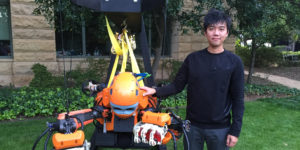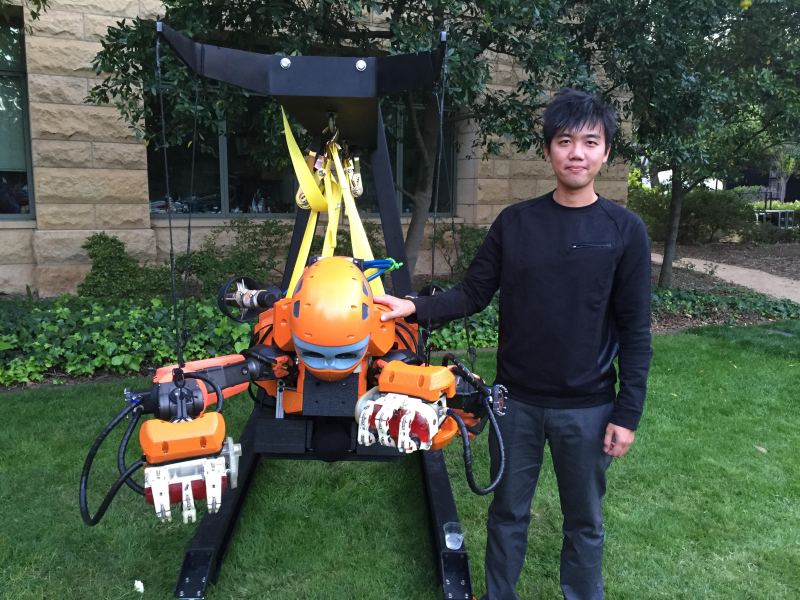
In this edition of Glam Grads, The Stanford Daily met with Xiyang Yeh, a Ph.D. student at the Department of Mechanical Engineering who works in the Robotics Group of professor computer science Oussama Khatib in the Stanford Artificial Intelligence Laboratory. Yeh earned his master’s degree in mechanical engineering at Stanford in 2012, and his bachelor’s degree in mechanical engineering at the National University of Singapore in 2008. Prior to joining Stanford, he worked as a research engineer at the Singapore Institute of Manufacturing Technology where he focused on integrating robotic manipulators into assembly lines to facilitate manufacturing processes. Yeh is currently working on the Ocean One project and shares with The Daily his interests in mechanical engineering, current research, future plans and advice for aspiring mechanical engineers.
The Stanford Daily (TSD): What do you like most about Stanford? How is it different from studying in Singapore?
XY: Stanford is a very different environment. This is Silicon Valley, and startups are part of the culture, technology has been moving really fast, and there is a lot of support. Singapore is more of a business hub, so it was not as exciting in terms of technological advancements. When I came here, there were a lot of opportunities for mechanical engineers.
TSD: What got you interested in robotics?
XY: I started robotics back when I was doing my undergraduate studies in Singapore. I was first into physics, but I found it a bit dry. Because I liked hardware and things that move, I switched to robotics. I started with this competition called Robocup, which involves humanoid robots playing soccer. That was 10 years ago.
TSD: Why did you choose to study mechanical engineering as a Ph.D.?
XY: Originally I wanted to study physics, but I felt that mechanical engineering was more interdisciplinary. It involves electronics, building, designing–even coding–and so many other hardware/software integrations. Those have been my passions, and they have carried me forward to where I am today, going from building small robots to this big underwater one.
TSD: What advice would you give to people who plan to major in mechanical engineering?
XY: Explore the field, and find something that you really like and are passionate about. After all, you need to like what you want to do, so in the industry, you can find a job that you really like, or in academia, you can find research you are really passionate about. To explore and really find a direction is really important because it will carry you a long way.
TSD: Tell me about your research at the Stanford Robotics Lab.
XY: We are interested in designing and controlling really articulate systems, basically with a lot of joints and limbs–for example, a humanoid. I am interested in search and rescue and field applications where humans are unable to access underwater or in space. So I got involved with the Ocean One project. The Ocean One is a multi-degree of freedom robot that we are building for archaeologists and scientists to explore the depths for artifacts and samples.
TSD: I read that your research work revolves around proposing “design-for-control principles for highly articulated robotic systems” and that the proposed methodologies have been utilized in the design of Ocean One. Would you please elaborate?
XY: In industry, most of time you are dealing with big companies–hence really structured environments. There are hardware engineers and software engineers, and most of the time because [of] the time frames and the production cycles, people cannot go outside of their core expertise, making it really difficult for mechanical engineers and software engineers to come together and solve things.
My background is actually in controls, but I decided to switch to design because while I was doing controls, I realized that a lot of problems that come from hardware would be easier and more efficiently solved when tackled earlier on.
TSD: What are the future plans for the Ocean One project?
XY: As of now, we are trying to go to greater depths. Initially, we tested it in the pool here for the one meter trial and last year we sent it to France to test it for a 91 meters trial. So, the next expedition will be to 500 meters, and later on it will probably be to 1,000 meters. It is pretty exciting because it will be to depths where humans are not allowed to go, so there are a lot of engineering challenges to upgrade our system.
TSD: What are your plans for the future? What’s your dream job?
XY: For me it is more about the type of the job. I am interested in product development and commercializing products. Basically, my dream job would be to lead a group of very motivated engineers to work on and solve very complicated problems, not just from a scientific point of view, but to really commercialize the industry.
Contact Diva-Oriane Marty at [email protected].
